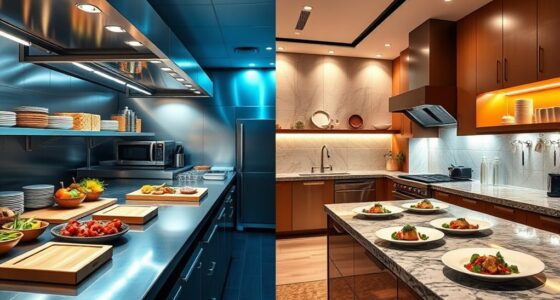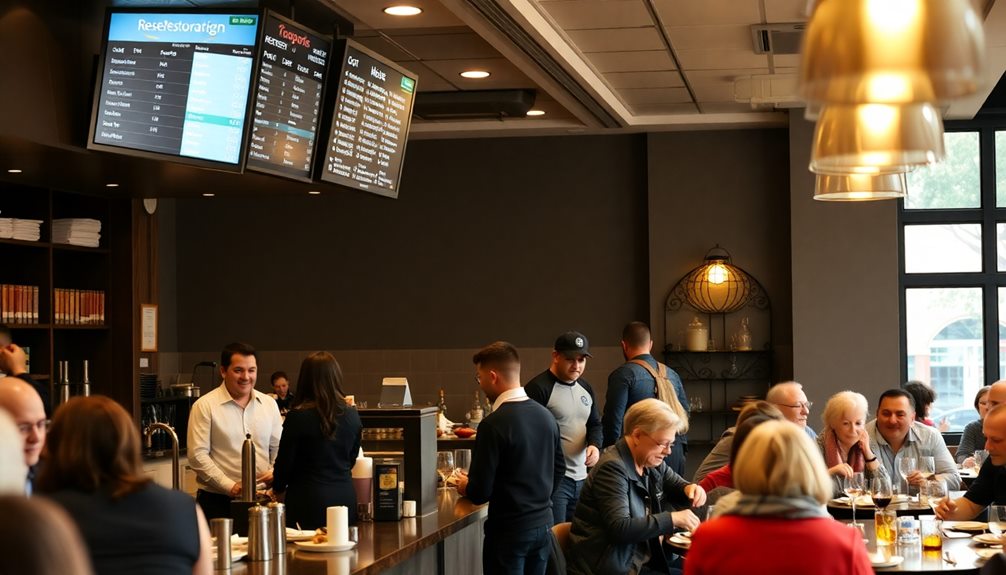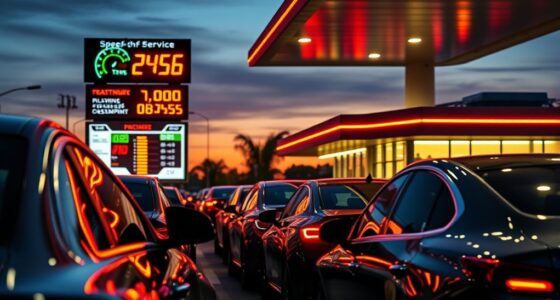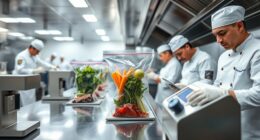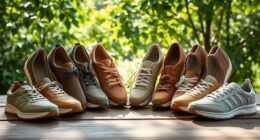Restaurants keep food fresh by maintaining strict temperature controls, guaranteeing refrigeration stays below 40°F and freezers below 0°F. They follow hygiene standards, like regular handwashing and surface sanitization, to prevent cross-contamination. Utilizing methods like vacuum sealing and FIFO (first-in, first-out) helps minimize spoilage. Staff are trained in proper food handling techniques to further reduce risks. Restaurants also source fresh ingredients locally and conduct regular inventory audits to keep track of items approaching expiration. This careful balance of practices not only guarantees food quality but also enhances flavor and safety. There's even more to explore about their methods.
Key Takeaways
- Restaurants maintain refrigeration at or below 40°F (4°C) to inhibit microbial growth and preserve food freshness.
- The FIFO (First In, First Out) method is employed to utilize older stock first, reducing food waste.
- Regular handwashing and surface sanitization prevent cross-contamination and minimize spoilage risks.
- Vacuum sealing and airtight containers protect food from oxygen exposure, extending shelf life and preserving quality.
- Local sourcing of fresh ingredients enhances flavor, quality, and sustainability while reducing transportation time.
Understanding Food Spoilage

Food spoilage is a common challenge that every restaurant faces, and understanding its causes is necessary to maintaining freshness. Microbial growth, chemical reactions, and physical damage are the primary culprits behind spoilage, leading to unpleasant odors, textures, and appearances in your food products.
You need to be particularly aware of the "danger zone" temperatures between 40°F (4°C) and 140°F (60°C), where microbial growth thrives. That's why strict temperature management in food storage is essential.
Cross-contamination can also greatly contribute to food spoilage. It can occur through direct contact or contaminated surfaces, so maintaining hygiene practices in food handling is crucial.
In addition, chemical changes like oxidation and enzymatic browning can degrade both the sensory and nutritional quality of food. To combat this, you should adopt proactive preservation techniques.
Proper food storage techniques, such as keeping refrigeration at ideal temperatures and utilizing FIFO (First In, First Out) inventory management, are necessary in minimizing spoilage risks.
Operational Factors Influencing Spoilage
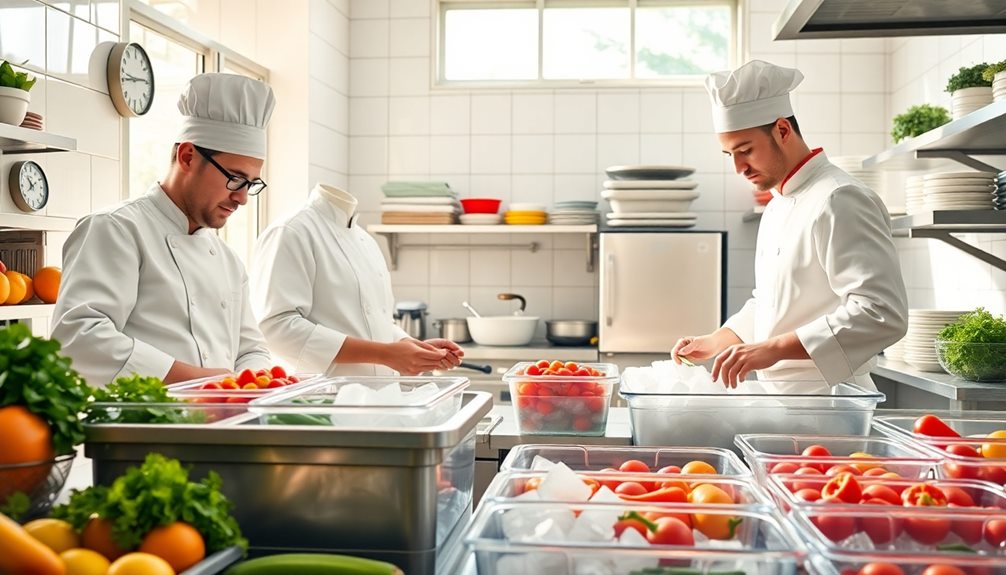
When you manage temperatures properly, you markedly reduce the risk of food spoilage.
Keeping your kitchen clean and adhering to hygiene standards is just as essential, as it prevents contamination.
Plus, using effective food storage techniques guarantees that your ingredients stay fresh and safe for your customers.
Temperature Management Practices
Keeping food fresh hinges on effective temperature management practices. You must maintain refrigeration units at or below 40°F (4°C) and freezers at or below 0°F (-18°C) to inhibit microbial growth and extend the shelf life of perishable foods. Regularly monitoring storage temperatures with calibrated thermometers guarantees compliance with food safety standards and minimizes spoilage risks.
Implementing the FIFO (First In, First Out) inventory management method helps you reduce food waste by using older stock before newer items. This practice not only keeps your inventory fresh but also saves money in the long run.
Proper food storage techniques, such as using airtight containers and vacuum sealing, protect against oxidation and moisture, both of which can accelerate spoilage.
Staff training on safe handling practices is essential. You need to avoid the "danger zone" of 40°F to 140°F (4°C to 60°C) to prevent foodborne illnesses and maintain food freshness.
Hygiene and Sanitation Standards
Maintaining high hygiene and sanitation standards in your restaurant directly impacts food freshness and safety. By implementing strict hygiene practices, like regular handwashing and sanitizing surfaces, you can prevent cross-contamination and reduce spoilage risks considerably.
It's important to keep raw and ready-to-eat foods separate, as this is essential for food safety and extending freshness.
Regular staff training on food handling and sanitation protocols plays a key role in minimizing spoilage chances. When your team understands the importance of these practices, you guarantee compliance with safety regulations.
Additionally, maintaining clean storage areas and equipment, along with conducting routine inspections, helps you identify potential spoilage risks before they affect food quality.
Adhering to recommended temperature control guidelines is another fundamental element. For instance, keeping refrigeration units below 40°F (4°C) is crucial for inhibiting microbial growth and prolonging food shelf life.
Effective Food Storage Techniques
Effective food storage techniques are essential in preventing spoilage and ensuring the longevity of your restaurant's inventory. Maintaining refrigeration temperatures at or below 40°F (4°C) and freezing temperatures at or below 0°F (-18°C) is critical for inhibiting microbial growth. This careful temperature control plays an important role in food preservation.
Implementing the FIFO (First In, First Out) method helps you manage your inventory efficiently. By using older products first, you minimize the risk of spoilage and waste. Regular monitoring and maintenance of your refrigeration units are equally important, as slight temperature fluctuations can lead to spoilage.
To enhance your storage environment, consider utilizing airtight containers and vacuum sealing. These methods greatly reduce oxygen exposure, which helps in keeping food fresh for a longer time.
Additionally, strict adherence to hygiene practices—like regular cleaning of storage areas and preventing cross-contamination—is essential for maintaining food quality and safety.
Proactive Tips for Freshness
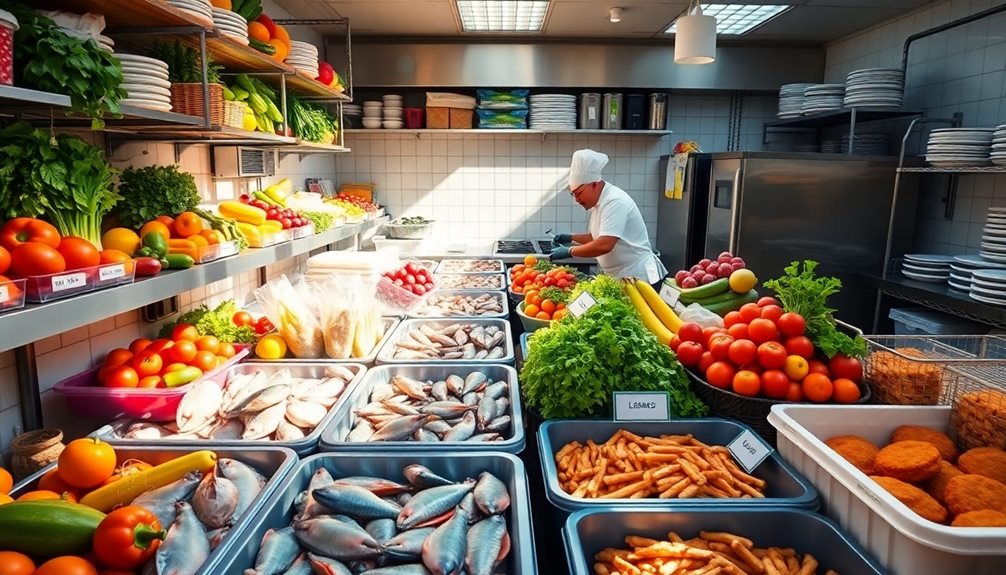
When it comes to guaranteeing food freshness, a few proactive strategies can make all the difference.
First, maintain your refrigeration at or below 40°F (4°C) and freezers at or below 0°F (-18°C). This inhibits microbial growth and preserves food quality.
Next, utilize vacuum sealing and airtight containers to keep your restaurant's food protected from oxygen exposure, extending its shelf life while maintaining flavor.
Implement a First In, First Out (FIFO) inventory management system to make certain you use older stock first. This not only helps in reducing waste but also guarantees that your customers enjoy the freshest meals possible.
Conduct regular inventory audits to identify near-expiration items. This allows for timely use or removal before spoilage occurs.
Food Handling and Preparation
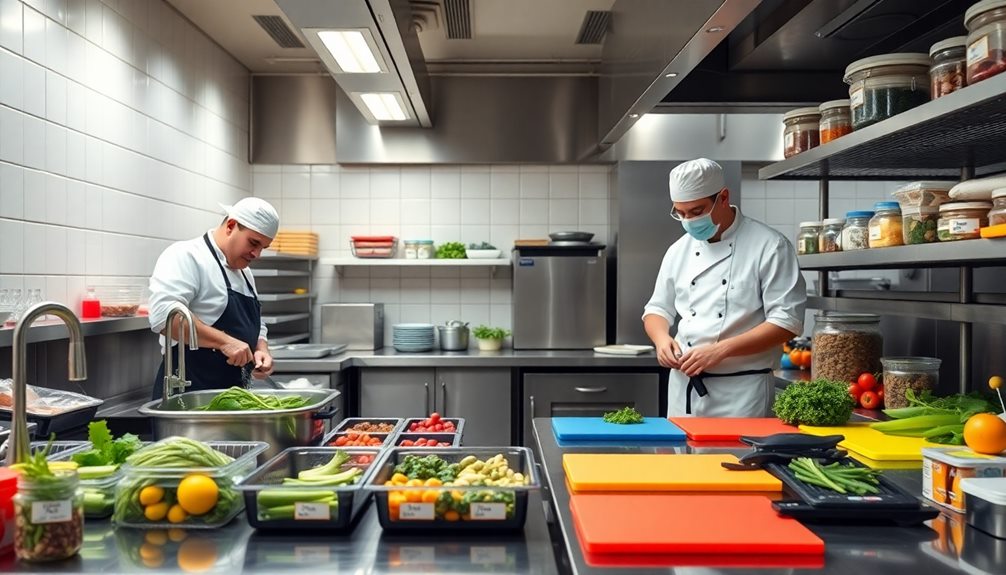
When it comes to food handling and preparation, hygiene and safety protocols are your first line of defense against spoilage and contamination.
Understanding the importance of financial considerations for elderly care can also play a role in ensuring that food resources are allocated efficiently and safely.
You'll want to keep a close eye on temperature control practices, ensuring foods are prepared and stored at safe levels.
Plus, utilizing preservation techniques can't only extend the shelf life of ingredients but also enhance their flavors.
Hygiene and Safety Protocols
Maintaining high hygiene and safety protocols in restaurants is essential for ensuring food safety and preventing contamination. You need to understand that every step in food handling and preparation matters.
First, staff undergo regular training on hygiene practices, emphasizing proper handwashing techniques. This minimizes contamination risks during food prep.
Here are three crucial hygiene and safety protocols you should keep in mind:
- Sanitize surfaces and utensils frequently to prevent cross-contamination.
- Store foods correctly — refrigerate at or below 40°F (4°C) and keep hot foods at 165°F (74°C).
- Separate raw and ready-to-eat foods during preparation to avoid cross-contamination.
Temperature Control Practices
Proper temperature control practices are key to keeping food fresh and safe in restaurants. Maintaining refrigeration at or below 40°F (4°C) and freezing at or below 0°F (-18°C) is vital for inhibiting microbial growth. You should also avoid leaving food at room temperature for more than 2 hours to minimize spoilage and reduce the risk of foodborne illnesses.
Regularly monitoring food temperatures during cooking and storage guarantees that products remain in the safe temperature zone. This is essential for food safety. Implementing strict hygiene practices, like hand washing and sanitizing surfaces, reduces cross-contamination risks during food handling.
Utilizing the FIFO (First In, First Out) method helps guarantee older inventory is used before newer stock, which reduces waste and maintains quality.
Here's a quick reference table for your temperature control practices:
| Temperature Zone | Recommended Action |
|---|---|
| Refrigeration (40°F/4°C) | Store perishable items here |
| Freezing (0°F/-18°C) | Keep items frozen |
| Room Temperature (above 40°F) | Limit exposure to 2 hours |
| Cooking (165°F/74°C) | Guarantee food reaches this temp |
| FIFO Best Practice | Use older stock first |
Preservation Techniques Utilization
Freshness is essential in the restaurant industry, and utilizing effective preservation techniques plays a significant role in achieving this. By implementing strategies that guarantee food safety, you can maintain the quality of your ingredients while minimizing waste.
Understanding the importance of common financial terms can also help restaurant owners manage their operational costs effectively. Here are three key techniques to reflect on:
- Vacuum sealing and airtight containers: Prevent oxygen exposure and slow spoilage processes.
- FIFO (First In, First Out): Use older items first to guarantee freshness and respect expiration dates.
- Temperature monitoring: Keep foods at safe temperatures, ideally below 40°F (4°C) for refrigeration and below 0°F (-18°C) for freezing.
Incorporating these preservation techniques not only extends the shelf life of your ingredients but also enhances their flavors and nutritional value.
Remember, proper food handling is imperative—minimizing the time food spends at room temperature reduces the risk of microbial growth. By establishing clear protocols for food preparation, you can maintain high standards in your kitchen.
Ultimately, these practices contribute to delivering fresh, delicious meals that keep your customers coming back for more.
Food Storage and Safety Techniques

Effective food storage and safety techniques are essential for restaurants to guarantee their ingredients remain safe and high-quality. To maintain food freshness, keep refrigeration temperatures at or below 40°F (4°C) and freezers at or below 0°F (-18°C). This helps inhibit microbial growth and spoilage.
Implementing the FIFO (First In, First Out) inventory management system is important to minimize waste, ensuring older stock gets used before newer items. Always label food items with dates and store them in airtight containers to prevent cross-contamination and maintain quality. Regular temperature checks using calibrated thermometers are critical for complying with food safety standards.
Here's a quick reference table to help you remember key food storage practices:
| Food Type | Storage Temperature | Handling Tips |
|---|---|---|
| Dairy Products | ≤ 40°F (4°C) | Keep away from raw meats |
| Meats | ≤ 40°F (4°C) | Store on lower shelves |
| Frozen Foods | ≤ 0°F (-18°C) | Use within recommended time |
| Ready-to-Eat | ≤ 40°F (4°C) | Separate from high-risk foods |
| Dry Goods | Cool, Dry | Store in airtight containers |
Sourcing Fresh Ingredients
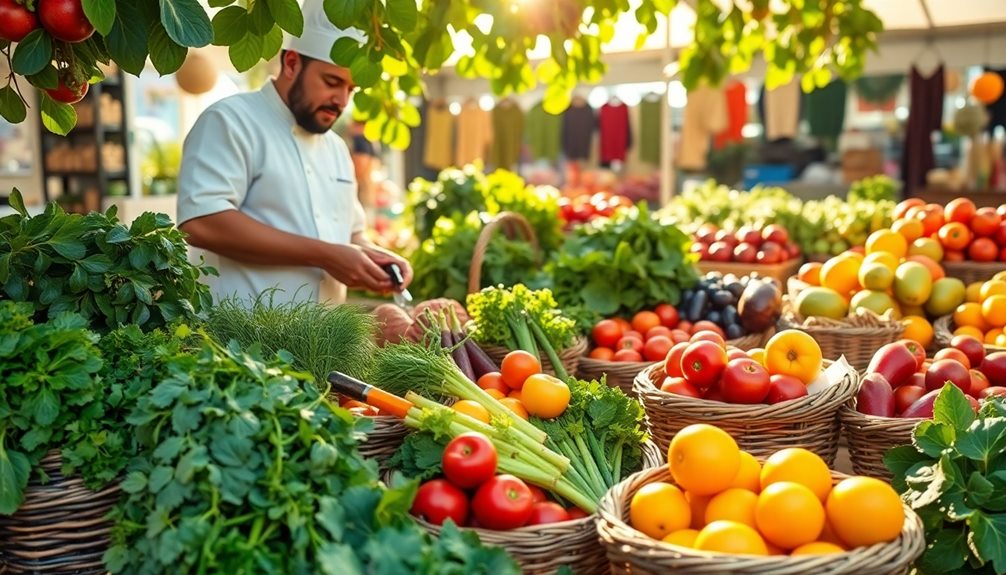
When it comes to sourcing fresh ingredients, restaurants often turn to local suppliers to guarantee high-quality and flavor. By partnering with nearby farms, they can access seasonal and organic options, which not only enhances the quality of food products but also supports sustainable practices.
This close relationship helps reduce transportation time, ensuring that the ingredients you enjoy are as fresh as possible.
Here are three reasons why local sourcing matters:
- Flavor: Freshly picked produce has unmatched taste, making every dish more delightful.
- Quality: Local suppliers often have clear certifications, ensuring you receive superior, safe ingredients.
- Sustainability: Supporting local farmers helps promote eco-friendly practices that benefit the community.
Regularly evaluating the cost-effectiveness of sourcing fresh ingredients helps restaurants balance quality with expenses.
Plus, implementing a streamlined inventory management system allows them to track ingredient freshness and usage, which minimizes waste and ultimately reduces spoilage.
Stock Control Strategies

Maintaining high-quality ingredients doesn't stop at sourcing; it extends into how restaurants manage their stock. Effective stock control strategies are essential for keeping food fresh and minimizing waste. One key approach is using analytic software to monitor customer trends and ingredient usage. This helps you forecast demand more accurately, allowing for better inventory management.
Implementing a First In, First Out (FIFO) system guarantees that older stock gets used before newer items, greatly reducing spoilage. Additionally, placing smaller, frequent orders instead of bulk purchases can keep your ingredients fresher and decrease waste, as they get used up quickly.
Simplifying your menu can also play an important role by limiting ingredient variety, which helps reduce potential waste while promoting dishes that utilize ingredients close to expiration.
Regular inventory audits are fundamental too; these audits help you identify near-expiration items for timely use or removal, thereby maintaining freshness.
Quality Assurance in Sourcing
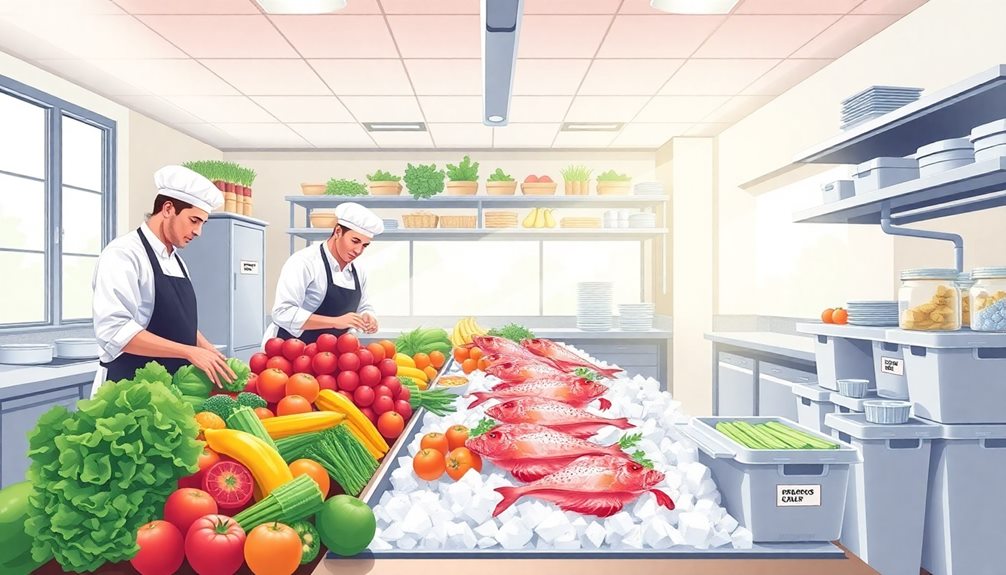
Sourcing high-quality ingredients is essential for any restaurant aiming to deliver exceptional dishes. To guarantee quality assurance and food safety, you need to partner with reputable suppliers who meet strict standards. Here are three critical steps to achieve that:
- Research Suppliers: Look for suppliers with positive reviews and certifications, such as USDA, to confirm their compliance with safety regulations.
- Evaluate Packaging: Check the methods suppliers use for packaging and transit. Confirm they implement temperature control measures to prevent spoilage and maintain freshness.
- Establish Policies: Create clear return and refund policies with your suppliers. This approach allows you to address any quality issues quickly, affirming your customers always receive the best.
Regularly auditing supplier practices helps you identify potential risks in your sourcing process.
By engaging in local sourcing whenever possible, you can further enhance ingredient quality and flavor, reducing transportation time.
Prioritizing these steps not only boosts your restaurant's reputation but also keeps your dishes fresh and delicious.
Enhancing Restaurant Environment

Creating a fresh and inviting restaurant environment directly impacts the quality of the dishes you serve. Investing in automated climate control systems guarantees consistent temperature and humidity levels, which are critical for preserving ingredient freshness. These systems help maintain ideal conditions that prevent spoilage and enhance flavors.
High-quality ventilation systems play an important role too. They help prevent moisture buildup, extending the shelf life of your ingredients by securing optimal air quality in your kitchen. Regular maintenance of refrigeration units is necessary, as it prevents temperature fluctuations that can compromise food safety and freshness.
Additionally, incorporating UV-C sanitation technology in food preparation areas effectively eliminates harmful pathogens, creating a safer environment for both staff and customers. This technology not only helps keep surfaces clean but also contributes to the overall freshness of the food you serve.
Implementing smart monitoring systems allows you to track storage conditions in real time. With immediate adjustments available, you can maintain ideal freshness levels for perishable items, guaranteeing your dishes remain as delicious and high-quality as possible.
Frequently Asked Questions
How Do Restaurants Get Fresh Food Every Day?
Restaurants source fresh food daily by partnering with local farmers and suppliers. They schedule regular deliveries to match menu needs, ensuring high-quality ingredients arrive quickly, minimizing travel time, and enhancing overall food freshness. This practice not only supports the local economy but also reduces the carbon footprint associated with long-distance transportation. Many of the best wwfriendly restaurants emphasize these sustainable sourcing methods, aligning culinary excellence with eco-conscious values. By prioritizing local partnerships, they deliver meals that are not only flavorful but also environmentally responsible.
How Do Restaurants Store Their Food?
Imagine a bustling kitchen, where fresh ingredients await your culinary touch. Restaurants store food meticulously, using ideal temperatures, airtight containers, and clear labels, ensuring safety and freshness while keeping everything organized and ready for your next delicious meal.
What Do Restaurants Use to Preserve Meat?
Restaurants use various methods to preserve meat, like vacuum sealing to reduce air exposure, marinating for flavor and moisture retention, and freezing to halt spoilage. Curing and smoking also enhance taste while extending shelf life.
How Do Restaurants Store Their Meat?
You open the fridge, cool air brushing against you, meat neatly organized. It's chilled below 40°F, vacuum-sealed tight. You follow FIFO, ensuring freshness, while inspecting each cut for any signs of spoilage before storage.
Conclusion
To keep food fresh, restaurants must stay proactive and vigilant. Did you know that nearly 10% of food produced globally gets wasted due to spoilage? By understanding spoilage factors and implementing effective storage and handling techniques, you can greatly reduce this waste. Sourcing fresh ingredients and maintaining a clean environment not only enhances the quality of your dishes but also keeps your customers happy. Remember, freshness isn't just a goal; it's a commitment to excellence in every bite!



